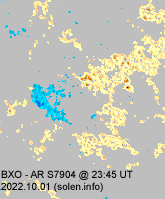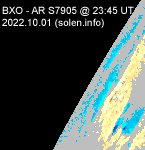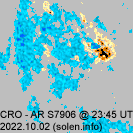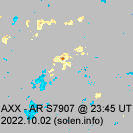

The geomagnetic field was quiet to minor storm on October 2. Solar wind speed at SOHO ranged between 377 and 589 km/sec. The high latitude magnetometer at Andenes recorded quiet to severe storm levels. A disturbance, likely related to the arrival of effects from CH1104, began after 20h UT.
Solar flux density measured at 20h UT on 2.8 GHz was 153.9 - increasing 23.7 over the previous solar rotation. (Centered 1 year average SF at 1 AU - 183 days ago: 114.25). The Potsdam WDC planetary A index was 12 (STAR Ap - based on the mean of three hour interval ap indices: 11.9). Three hour interval K indices: 22122325 (planetary), 22133324 (Boulder), 32122427 (Andenes).
The background x-ray flux is at the class C2 level (GOES 16).
At the time of counting spots (see image time), spots were observed in 11 active regions using 2K resolution (SN: 267) and in 10 active regions using 1K resolution (SN: 174) SDO/HMI images.
Region 13110 [N18W51] developed further with a
major part of the negative polarity area in the north surrounded by positive
polarity. The inversion line is fairly long and two major flares occurred
along that line. Further major flares are likely.
Region 13111 [N27E06] decayed slowly and quietly.
Region 13112 [N19E50] was quiet and stable. Note that SWPC include
the spots from AR S7901 in this region. If that interpretation was correct the region would
extend 24 degrees longitudinally.
Region 13113 [N16W41] developed slowly and was mostly quiet.
Region 13114 [S33E15] decayed slowly and quietly.
Spotted regions not observed (or interpreted
differently) by SWPC:
S7901 [N22E61] gained area and spots and is
magnetically very complex with multiple magnetic delta structures.
A major flare is possible.
S7902 [N28E57] was quiet and stable.
S7904 [S18E16] gained spots and area and was quiet.
S7905 [N30E68] gained spots and was quiet.
New region S7906 [S10E32] emerged with several spots.
New region S7907 [S25W37] emerged with a tiny spot.
C2+ flares:
| Magnitude | Peak time (UT) | Location | Source | Recorded by | Comment |
| C2.0 | 00:37 | 13110 | GOES16 | ||
| C2.4 | 01:37 | S7901 | GOES16 | ||
| M8.7/1N | 02:21 | N16W34 | 13110 | GOES16 | CME, weak type IV radio sweep |
| C2.6 | 04:47 | S7901 | GOES16 | ||
| C2.8 | 05:22 | 13110 | GOES16 | simultaneous flare in AR S7901 | |
| C4.1 | 06:21 | S7901 | GOES16 | incorrectly attributed to AR 13110 by SWPC | |
| C2.3 | 10:43 | S7901 | GOES16 | incorrectly attributed to AR 13110 by SWPC | |
| C2.4 | 11:39 | 13110 | GOES16 | simultaneous flare in AR S7901 | |
| C3.0 | 11:53 | N18W44 | 13110 | GOES16 | |
| C4.3 | 13:32 | S7901 | GOES16 | ||
| M1.2 | 14:05 | N25E73 | S7901 | GOES16 | |
| C8.7 | 14:57 | S29W77 | 13107 | GOES16 | |
| M1.0 | 15:45 | N22E69 | S7901 | GOES16 | |
| C3.6 | 17:34 | 13107 | GOES16 | simultaneous flare in AR S7901 | |
| C7.8 | 18:07 | N17W47 | 13110 | GOES16 | |
| C8.1 | 19:08 | S7901 | GOES16 | ||
| C5.5 | 19:44 | S7901 | GOES16 | ||
| M1.1 | 20:10 | S7901 | GOES16 | LDE | |
| X1.0 | 20:25 | 13110 | GOES16 | moderate type II radio sweep, minor increase in proton levels Simultaneous significant flare in AR S7901, see above |
|
| C4.9 | 22:00 | S7901 | GOES16 | ||
| C3.4 | 22:25 | S7901 | GOES16 | ||
| C9.0 | 23:08 | N22E66 | S7901 | GOES16 |
September 30: No obviously Earth directed CMEs were observed.
October 1: A filament eruption near AR 13113 peaked near 13h UT and
was associated with a partial halo CME. This CME could reach
Earth on October 4.
October 2: A faint full halo CME was observed after the M8 flare in
AR 13110 early in the day. The CME could reach Earth early on October 4.
[Coronal hole history (since October 2002)]
[Compare today's report to the situation one solar rotation ago:
28 days ago
27 days ago
26 days ago]
Recurrent coronal holes (CH1103/CH1104) were Earth facing on September 27 - October 1.

Long distance low and medium frequency (below 2 MHz) propagation along paths north of due west over upper middle and high latitudes is poor. Propagation on long distance northeast-southwest paths is poor.
Quiet to major conditions are likely on October 3-5, first due to effects from CH1104, then due to CME effects.
| Coronal holes (1) | Coronal mass ejection (2) | M and X class flares (3) |
1) Effects from a coronal hole
could reach Earth within the next 5 days. When the high speed
stream has arrived the color changes to green.
2) Effects from a CME are likely to be observed at Earth within 96 hours.
3) There is a possibility of either M or X class flares within the next 48 hours.
Green: 0-30% probability, Yellow: 30-70% probability, Red: 70-100% probability.
(Click on image for 2K resolution).
4K resolution.
Compare to the previous day's image. 0.5K image
When available the active region map has a coronal hole polarity overlay where red (pink) is negative and blue is positive.
Data for all officially numbered solar regions according to the Solar Region Summary provided by NOAA/SWPC, all other regions are numbered sequentially as they emerge using the STAR spot number. Comments are my own, as is the STAR spot count (spots observed at or inside a few hours before midnight) and data for regions not numbered by SWPC or where SWPC has observed no spots. SWPC active region numbers in the table below and in the active region map above are the historic SWPC/USAF numbers. SWPC data considered to be not sufficiently precise (location, area, classification) are colored red.
| Active region | SWPC date numbered STAR detected |
Spot count | Location at midnight | Area | Classification | SDO / HMI 4K continuum image with magnetic polarity overlays |
Comment | ||||
|---|---|---|---|---|---|---|---|---|---|---|---|
| SWPC/ USAF |
Magnetic (SDO) |
SWPC | STAR | Current | Previous | ||||||
| 2K | 1K | ||||||||||
| 13107 | 2022.09.20 2022.09.21 |
2 | S25W82 | 0030 | HSX |
 |
location: S24W79 spotless |
||||
| 13110 | 2022.09.22 2022.09.23 |
10 | 24 | 12 | N17W52 | 0180 | DAO | DAC |
 |
 |
beta-delta location: N18W51 |
| 13111 | 2022.09.26 2022.09.27 |
1 | 8 | 2 | N28E04 | 0070 | HSX | CSO |
 |
 |
location: N27E06 |
| S7893 | 2022.09.28 | S15W35 | |||||||||
| S7894 | 2022.09.29 | N12W11 | |||||||||
| 13113 | 2022.09.29 2022.09.30 |
8 | 31 | 11 | N16W40 | 0080 | DAI | DAI |
 |
 |
area: 0180 |
| S7897 | 2022.09.29 | N31W13 |
 |
||||||||
| 13114 | 2022.09.30 2022.10.01 |
3 | 7 | 4 | S34E11 | 0020 | BXO | BXO |
 |
 |
location: S33E15 |
| 13112 | 2022.09.30 2022.09.30 |
18 | 11 | 6 | N23E59 | 0750 | FKI | HAX |
 |
 |
area: 0180 location: N19E50 SWPC includes AR S7901 in this region |
| S7900 | 2022.09.30 | S26W37 | |||||||||
| S7901 | 2022.09.30 | 43 | 23 | N22E61 | 0720 | FKC |
 |
 |
beta-gamma-delta | ||
| S7902 | 2022.09.30 | 2 | 1 | N28E57 | 0005 | AXX |
 |
 |
|||
| S7903 | 2022.09.30 | S12E09 | |||||||||
| S7904 | 2022.10.01 | 12 | 6 | S18E16 | 0040 | CRI |
 |
 |
|||
| S7905 | 2022.10.01 | 12 | 5 | N30E68 | 0025 | BXI |
 |
 |
|||
| S7906 | 2022.10.02 | 6 | 4 | S10E32 | 0020 | CRO |
 |
||||
| S7907 | 2022.10.02 | 1 | S25W37 | 0001 | AXX |
 |
|||||
| Total spot count: | 42 | 157 | 74 | ||||||||
| Sunspot number: | 102 | 267 | 174 | (total spot count + 10 * number of spotted regions) | |||||||
| Weighted SN: | 72 | 193 | 110 | (Sum of total spot count + classification weighting for each AR. Classification weighting: X=0, R=3, A/S=5, H/K=10) | |||||||
| Relative sunspot number (Wolf number): | 112 | 147 | 139 | ||||||||
| Month | Average solar flux | International sunspot number (WDC-SILSO) |
Smoothed sunspot number (4) | Average ap (3) |
|
|---|---|---|---|---|---|
| Measured | 1 AU | ||||
| 2014.02 | 170.3 (cycle peak) |
166.3 | 146.1 (SC24 peak) | 110.5 | 10.70 |
| 2014.04 | 143.9 | 144.8 | 112.5 | 116.4 (solar max) | 7.88 |
| 2017.09 | 91.3 | 92.3 | 43.6 | 18.2 (-1.3) | 18.22 (cycle peak) |
| 2019.11 | 70.2 | 68.7 | 0.5 | 2.0 (-0.6) (Solar minimum using 365d smoothing: November 17, 2019) |
4.19 |
| 2019.12 | 70.8 | 68.6 | 1.6 | 1.8 (-0.2) (ISN 13 months smoothed solar minimum) |
3.22 |
| 2021.03 | 76.0 | 75.2 | 17.2 | 21.7 (+2.7) | 10.17 |
| 2021.04 | 75.9 | 76.4 | 24.5 | 24.8 (+3.1) | 8.40 |
| 2021.05 | 75.3 | 77.1 | 21.2 | 25.8 (+1.0) | 6.50 |
| 2021.06 | 79.4 | 81.8 | 25.0 | 27.6 (+1.8) | 5.52 |
| 2021.07 | 81.0 | 83.6 | 34.3 | 31.4 (+3.8) | 5.51 |
| 2021.08 | 77.7 | 79.7 | 22.0 | 35.4 (+4.0) | 6.19 |
| 2021.09 | 87.0 | 88.2 | 51.3 | 40.2 (+4.8) | 6.33 |
| 2021.10 | 88.9 | 88.3 | 37.4 | 45.2 (+5.0) | 7.38 |
| 2021.11 | 86.2 | 84.4 | 34.8 | 50.8 (+5.6) | 9.83 |
| 2021.12 | 103.0 | 99.8 | 67.5 | 55.9 (+5.1) | 6.40 |
| 2022.01 | 103.8 | 100.5 | 55.3 | 60.1 (+4.2) | 8.92 |
| 2022.02 | 109.1 | 106.5 | 60.9 | 64.8 (+4.7) | 10.46 |
| 2022.03 | 117.0 | 115.8 | 78.6 | 68.9 (+4.1) | 10.20 |
| 2022.04 | 130.8 | 131.7 | 84.0 | (74.2 projected, +5.3) | 11.79 |
| 2022.05 | 133.8 | 136.8 | 96.5 | (80.6 projected, +6.4) | 7.48 |
| 2022.06 | 116.1 | 119.8 | 70.3 | (86.5 projected, +5.9) | 8.20 |
| 2022.07 | 125.4 | 129.5 | 91.4 | (93.7 projected, +7.2) | 9.51 |
| 2022.08 | 114.2 | 117.1 | 75.4 | (100.2 projected, +6.5) | 10.92 |
| 2022.09 | 135.1 | 136.5 | 96.3 | (105.2 projected, +5.0) | 12.2 |
| 2022.10 | 150.9 (1) | 6.5 (2A) / 101.0 (2B) / 112.5 (2C) | (108.3 projected, +3.1) | (6.9) | |
| 2022.11 | (111.2 projected, +2.9) | ||||
| 2022.12 | (115.9 projected, +4.7) | ||||
| 2023.01 | (122.0 projected, +6.1) | ||||
| 2023.02 | (127.0 projected, +5.0) | ||||
| 2023.03 | (130.0 projected, +3.0) | ||||
| 2023.11 | (142.5 projected max SC25) | ||||
1) Running average based on the daily 20:00 UTC observed solar flux value at 2800 MHz
and any corrections applied to that measurement.
2A) Current impact on the monthly sunspot number based on the Boulder (NOAA/SWPC) sunspot number (accumulated daily sunspots / month days).
2B) Boulder SN current month average to date.
2C) STAR SDO 1K Wolf number 30 day average.
3) Running average based on the quicklook and definitive Potsdam WDC ap indices. Values in red
are based on the definitive international
GFZ Potsdam WDC ap indices.
4) Source: SIDC-SILSO.

This report has been prepared by Jan Alvestad. It is based on the analysis of data from whatever sources are available at the time the report is prepared. All time references are to Universal Time. Comments and suggestions are always welcome.
SDO images are courtesy of NASA/SDO and the AIA, EVE, and HMI science teams.